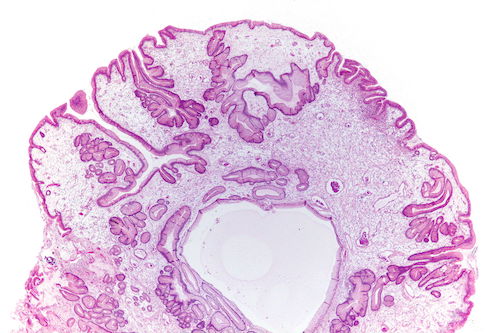Juvenile Polyposis Syndrome (JPS)/Familial Juvenile Polyposis
Raphael Moore, MD
The Operative Review of Surgery. 2023; 1:118-121.
Table of Contents
Pathophysiology and Presentation
Pathophysiology
- Mutations: SMAD4 (MADH4) or BMPR1A 1 Mn
- Autosomal Dominant
- “Juvenile” Refers to the Type of Polyps, Not the Age of Onset 2
- Presents with Multiple Hamartomas Throughout the GI Tract 3
- Colorectal (98%) – Most Common
- Stomach (14%)
- Duodenum (7%)
- Small Bowel (7%)
- Number of Polyps Varies from Few to Over 100 4
- Most Present with Some Polyps by Age 20 4
- Most Patients Have Symptoms of GI Bleeding and Anemia by Age 20
- Most Hamartomas are Benign but Malignant Transformation Can Occur
- Incidence of All GI Cancers: 11-86%
- Incidence of Colorectal Cancer: 17-22% by Age 35; 68% by Age 60 1,5
- Incidence of Upper GI Cancers: 21% 6
- Hereditary Hemorrhagic Telangiectasia (HHT)
- Present in 32% of Patients with an SMAD4 Mutation 7
- High Incidence of Pulmonary Arteriovenous Malformation (AVM) and Epistaxis 1
- Skeletal Stigmata (Macrocephalus, Hydrocephalus, Cleft Palate, Polydactyly, Hypertelorism) – 70% 2

Juvenile Polyp 8
Diagnosis and Management
Diagnosis 1,9
- Clinical Diagnosis: Based on One of the Following:
- > 5 Juvenile Polyps of the Colon or Rectum
- Multiple Juvenile Polyps of the Upper and Lower GI Tract
- Any Juvenile Polyps with a Family History of JPS
- Diagnosis Confirmed by Genetic Testing
Screening/Surveillance
- Colonoscopy Every 1-3 Years, Starting at Age 12-15 5,9,10
- Repeat Every Year if Polyps are Found
- Upper Endoscopy Every 1-3 Years, Starting at Age 12-15 5,9,10
- Repeat Every Year if Polyps are Found
Polyp Management
- Endoscopic Polypectomy to Decrease Risk of Bleeding and Malignancy 1
- Partial Stomach or Bowel Resection May Be Necessary in the Setting of Numerous Polyps to Relieve Symptoms or Decrease Cancer Risk 1
Indications for Colectomy 11
- Absolute Indications (2015 ACG Guidelines):
- Documented or Suspected Colorectal Cancer
- Significant Symptoms
- Relative Indications (2015 ACG Guidelines):
- Multiple Large Adenomas > 6 mm
- Significant Increase in Adenoma Number on Consecutive Exams
- Adenoma with High-Grade Dysplasia
- Inability to Adequately Survey the Colon Because of Multiple Diminutive Polyps
- Consider Partial vs Total Colectomy/Proctocolectomy
Other Colorectal Cancer and Polyposis Syndromes
Syndromes
- Familial Adenomatous Polyposis (FAP)
- Lynch Syndrome
- Juvenile Polyposis Syndrome (JPS)/Familial Juvenile Polyposis
- MUT Y Homolog (MUTYH)-Associated Polyposis (MAP)
- Peutz-Jeghers Syndrome (PJS)
- Serrated Polyposis Syndrome (SPS)
- PTEN Hamartoma Tumor Syndromes: (PHTS)
Comparisons
Mnemonics
Genetic Mutations in Familial Juvenile Polyposis
- Juveniles Get “MAD” Easily (SMAD4/MADH4) and “BUMP” Music (BMPR1A)
References
- Larsen Haidle J, MacFarland SP, Howe JR. Juvenile Polyposis Syndrome. 2003 May 13 [updated 2022 Feb 3]. In: Adam MP, Mirzaa GM, Pagon RA, Wallace SE, Bean LJH, Gripp KW, Amemiya A, editors. GeneReviews
- Dal Buono A, Gaiani F, Poliani L, Laghi L. Juvenile polyposis syndrome: An overview. Best Pract Res Clin Gastroenterol. 2022 Jun-Aug;58-59:101799.
- Schreibman IR, Baker M, Amos C, McGarrity TJ. The hamartomatous polyposis syndromes: a clinical and molecular review. Am J Gastroenterol. 2005 Feb;100(2):476-90.
- van Leerdam ME, Roos VH, van Hooft JE, Dekker E, Jover R, Kaminski MF, Latchford A, Neumann H, Pellisé M, Saurin JC, Tanis PJ, Wagner A, Balaguer F, Ricciardiello L. Endoscopic management of polyposis syndromes: European Society of Gastrointestinal Endoscopy (ESGE) Guideline. Endoscopy. 2019 Sep;51(9):877-895.
- Brosens LA, van Hattem A, Hylind LM, Iacobuzio-Donahue C, Romans KE, Axilbund J, Cruz-Correa M, Tersmette AC, Offerhaus GJ, Giardiello FM. Risk of colorectal cancer in juvenile polyposis. Gut. 2007 Jul;56(7):965-7.
- Howe JR, Mitros FA, Summers RW. The risk of gastrointestinal carcinoma in familial juvenile polyposis. Ann Surg Oncol. 1998 Dec;5(8):751-6.
- Blatter R, Tschupp B, Aretz S, Bernstein I, Colas C, Evans DG, Genuardi M, Hes FJ, Hüneburg R, Järvinen H, Lalloo F, Moeslein G, Renkonen-Sinisalo L, Resta N, Spier I, Varvara D, Vasen H, Latchford AR, Heinimann K. Disease expression in juvenile polyposis syndrome: a retrospective survey on a cohort of 221 European patients and comparison with a literature-derived cohort of 473 SMAD4/BMPR1A pathogenic variant carriers. Genet Med. 2020 Sep;22(9):1524-1532.
- Nephron, Wikimedia Commons. (License: CC BY-SA 3.0)
- Syngal S, Brand RE, Church JM, Giardiello FM, Hampel HL, Burt RW; American College of Gastroenterology. ACG clinical guideline: Genetic testing and management of hereditary gastrointestinal cancer syndromes. Am J Gastroenterol. 2015 Feb;110(2):223-62; quiz 263.
- Boland CR, Idos GE, Durno C, Giardiello FM, Anderson JC, Burke CA, Dominitz JA, Gross S, Gupta S, Jacobson BC, Patel SG, Shaukat A, Syngal S, Robertson DJ. Diagnosis and Management of Cancer Risk in the Gastrointestinal Hamartomatous Polyposis Syndromes: Recommendations From the US Multi-Society Task Force on Colorectal Cancer. Gastroenterology. 2022 Jun;162(7):2063-2085.
- Syngal S, Brand RE, Church JM, Giardiello FM, Hampel HL, Burt RW; American College of Gastroenterology. ACG clinical guideline: Genetic testing and management of hereditary gastrointestinal cancer syndromes. Am J Gastroenterol. 2015 Feb;110(2):223-62; quiz 263.